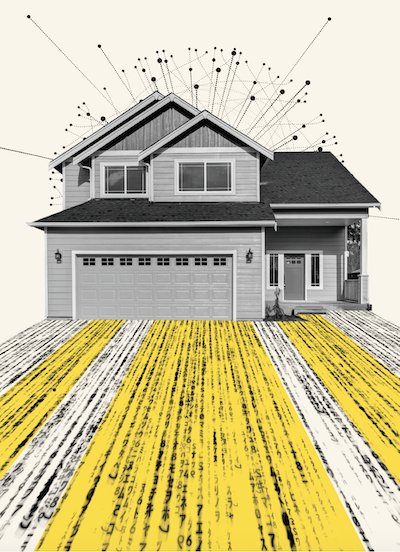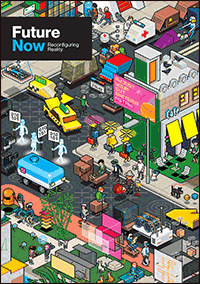Future Now
The IFTF Blog
Homegrown Governance
When smart homes become citizens of common-interest communities
The statistics just keep piling up: in government, we don’t trust.
 Around the world, governments are the least trusted institution in half of the 28 countries surveyed for the Edelman Trust Barometer. In the United States, according to Pew surveys, trust in the federal government is at an all-time low, having dropped from nearly 80 percent in the 1960s to about 19 percent in 2017. Government leaders are barely credible, trusted by only 29 percent of people surveyed worldwide. And trust in the political wisdom of the American public has dropped to somewhere between 23 percent and 37 percent, depending on political affiliation. The distrusters lay the blame on everything from corruption, to eroding social values, and to the pace of technological change.
Around the world, governments are the least trusted institution in half of the 28 countries surveyed for the Edelman Trust Barometer. In the United States, according to Pew surveys, trust in the federal government is at an all-time low, having dropped from nearly 80 percent in the 1960s to about 19 percent in 2017. Government leaders are barely credible, trusted by only 29 percent of people surveyed worldwide. And trust in the political wisdom of the American public has dropped to somewhere between 23 percent and 37 percent, depending on political affiliation. The distrusters lay the blame on everything from corruption, to eroding social values, and to the pace of technological change.
Then, it’s perhaps ironic, that rapidly changing technology may just offer up a solution to the trust problem. This solution is embedded governance, and it anticipates a world where governance is built in, technologically, to objects of daily life. A Nest thermostat might not simply adjust your home air conditioning based on your patterns of use—it might also automatically conform to local ordinances governing minimum thermostat settings. Your smart house thus becomes a smart citizen.
The enabling technologies are the usual suspects. Sensors monitor the physical environment. Blockchain-style distributed computing executes contracts and keeps immutable records of both good and bad behavior. Artificial intelligence computationally optimizes outcomes for a set of stated values. This is hyperlocal governance—it’s governance you can see and touchand adjust at the scale of neighborhoods. The first place it might take hold is in the hyperlocal governance structure, known as “common-interest communities.”
Local But Not Always Trusted
Common-interest communities have been part of the American landscape for at least half a century. They include homeowner’s associations (HOAs), condominium communities, and cooperative housing. In 1970, they governed about 2.1 million residents. They have grown impressively over recent decades to govern more than 68 million in 2016. All tallied, they number close to 350,000 communities today, compared to about 20,000 incorporated towns and cities.
The governing documents of these associations—their constitutions, if you will—are known as Covenants, Conditions, and Restrictions (CC&Rs), and anyone who has ever bought a residence with a CC&R knows that they bear careful study before investing. They govern everything from noise levels and landscape design to architecture and parking restrictions. Many of them provide maintenance services as well as the basic infrastructure that municipalities would normally provide. They levy fines for noncompliance and charge monthly or annual fees, not unlike the taxes a town might collect. They typically have a governing board as well as volunteer committee members. So they’re about as local as a government entity can get.
However, that doesn’t mean they’re always trusted. While the majority of residents report friendly relationships with their boards, these are not generally democratic entities. There are plenty of HOA horror stories and “bully boards” that exemplify the worst of small-pond politics. Enforcement of CC&Rs can be arbitrary and fines can be disproportionate to the offenses. Fines have been compounded by collection agencies to the point that they threaten the owners’ ability to keep their homes, or even to sell them. Neighbors can still find themselves at odds, often with mediators chosen to suit the interests of the board members. So even at this scale, corruption and conflict can undermine the sense of trust in the community and those who oversee it.
Trustless Systems for Community Trust
 Enter embedded governance. Embedded governance is automated governance, and it will employ the same disruptive technologies that are automating other sectors of society. Sensors will monitor everything from noise levels to water use to pet traffic, sending a plethora of signals to smart devices to determine if codes have been violated. Distributed computing will offer up smart contracts that use blockchain-style technology to read the sensor reports and automatically send warnings to any offenders. If an offender has agreed to the contract, fines may be both imposed and paid automatically. Finally, artificial intelligence (AI) will help individuals avoid these transgressions by anticipating possible offenses and automatically adjusting the appropriate systems. For example, AI systems might control 4D plumbing materials to adjust the water pressure in a home’s irrigation system based on anticipated weather, soil moisture, monthly water quotas, and observed patterns of water use in a household. Or it might simply move a semi-autonomous car to a legal parking space to avoid parking fines.
Enter embedded governance. Embedded governance is automated governance, and it will employ the same disruptive technologies that are automating other sectors of society. Sensors will monitor everything from noise levels to water use to pet traffic, sending a plethora of signals to smart devices to determine if codes have been violated. Distributed computing will offer up smart contracts that use blockchain-style technology to read the sensor reports and automatically send warnings to any offenders. If an offender has agreed to the contract, fines may be both imposed and paid automatically. Finally, artificial intelligence (AI) will help individuals avoid these transgressions by anticipating possible offenses and automatically adjusting the appropriate systems. For example, AI systems might control 4D plumbing materials to adjust the water pressure in a home’s irrigation system based on anticipated weather, soil moisture, monthly water quotas, and observed patterns of water use in a household. Or it might simply move a semi-autonomous car to a legal parking space to avoid parking fines.
At the heart of these scenarios are so-called trustless systems that use redundancy, transparency, pseudonymity, and immutability to build trust and confidence that rules are being applied fairly. Open records shared on many platforms, make these systems work. As in bitcoin exchanges, sensor data can be confirmed by multiple “observers.” Smart contracts can be executed pseudonymously, so that everyone can be assured that violations are prosecuted without necessarily knowing the violator. No one can tamper with records because everyone has a copy and everything is transparent.
While such systems have been heralded as a new way to conduct transnational commerce, common-interest communities like homeowners associations are actually a logical starting place for giving embedded governance a trial run. American HOAs are currently growing at a rate of about 40 percent per decade, and the new housing developments they govern can readily incorporate new smart home technology that may eventually underpin embedded governance. Smart home technologies are selling points for those buying into these new communities, creating personal value for the householder. But can they provide community value in the form of trusted governance systems? Can smart homes really be smart local citizens?
We Trust In … Contracts and Coins
The answer to this question will ultimately depend on the values we embed into the code—literally, the computer code—that we choose to run our communities. Human governance systems tend to polarize into two camps: the law-and-order camp and the free-to-innovate camp. Both will find much to praise in the embedded governance tools of the coming decade, but the tone of life in each will provide stark contrast.
The law-and-order HOAs will tend to emphasize contracts that enforce restrictions and automatically punish individual violators. They guarantee that the letter of the law is the lived law. Programmed to conform precisely to codes, smart homes can be very good law-and-order citizens, but they will tend to produce communities of conformity. Regardless of the specific values of these communities, lifestyles will feel legislated and even enforced by the physical infrastructure of daily life.
The free-to-innovate communities will tend to invest their trust in the “coin.” They will look for all the ways they can pool their collective resources and leverage individual resources and build new wealth for everyone. Their smart homes will need to do more than conform to be good citizens: they will need to connect, to build value from the exchange of data (as well as energy and other resources) among households. Every household will be a complex set of financial instruments for managing both physical and digital resources, and smart homes, as good citizens, will coach human householders to grow their personal equity while optimizing community goals with everything from neighborhood power grids to annual household dividends from community investments. Governance will be less about enforcement and more about turning community values into community wealth.
The next decade will likely see a great deal of experimentation with smart home technology and ultimately with governance strategies embedded in that technology.
The question is: should humans trust their smart homes, not just to be their proxy citizens, but actually to govern their communities? Common-interest communities offer a natural laboratory for exploring this question systematically. By thinking beyond the convenience of home automation to design homes intentionally as complex community governance systems, can we test the viability of contracts and coins, alongside sensors and AI, to organize human societies?
 FUTURE NOW—Reconfiguring Reality
FUTURE NOW—Reconfiguring Reality
This third volume of Future Now, IFTF's print magazine powered by our Future 50 Partnership, is a maker's guide to the Internet of Actions. Use this issue with its companion map and card game to anticipate possibilities, create opportunities, ward off challenges, and begin acting to reconfigure reality today.
About IFTF's Future 50 Partnership
Every successful strategy begins with an insight about the future and every organization needs the capacity to anticipate the future. The Future 50 is a side-by-side relationship with Institute for the Future: a partnership focused on strategic foresight on a ten-year time horizon. With 50 years of futures research in society, technology, health, the economy, and the environment, we have the perspectives, signals, and tools to make sense of the emerging future.
For More Information
For more information on IFTF's Future 50 Partnership and Tech Futures Lab, contact:
Sean Ness | sness@iftf.org | 650.233.9517



